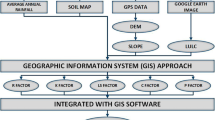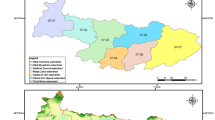Abstract
Runoff coefficients are widely used as a diagnostic variable of runoff generation in process studies and as an important input parameter in hydrologic design. Many regions of Saudi Arabia do not have sufficient historical records and the detailed runoff information needed for physically based distribution models. The US Department of Agriculture, Natural Resources Conservation Service Curve Number (USDA-NRCS-CN) method was used in this study for determining the curve number and runoff depth for Asir region, Saudi Arabia. Runoff curve number was determined based on the factors of hydrologic soil group, land use and land cover, and slope gradient in the Asir region of Saudi Arabia using the geographic information system (GIS). The region was not subjected before for any previous studies concerning runoff generation or rainwater harvesting by using GIS and remote sensing. ArcGIS 9.3 and the global positioning system were used to develop the soil map on the basis of samples collected during a field survey. Soil textures were identified and used to build a map of the hydrological soil groups. Unsupervised and supervised classification of Landsat images was used to generate land use and land cover maps. The land cover distribution in the study area revealed that the largest class in the area, barren and sparsely vegetated land, occupied 62,832.38 km2 of the study area (more than 80 % of the total area), followed by shrubland (15,212.66 km2), cropland and pasture (52.34 km2), mixed shrubland/grassland (40.89 km2), and grassland (12.27 km2). Built-up land occupied only 11.45 km2. The slope map for the Asir region was generated from a 15-m digital elevation model. The GIS technique was used to develop the CN for the region based on the Soil Conservation Service method. The annual runoff depth was derived from the annual rainfall and CN per pixel using the raster calculator tool in ArcGIS. The rainfall distribution in the study area showed the wise identification of suitable sites for rainwater harvesting, as most of the constructed dams were located in the areas with higher rainfall. The analysis also revealed that the annual runoff for the study area ranged from 27 to 69 % of the total rainfall, with variation as low as 80 to 300 mm/year. This is the highest amount of runoff that can be generated in Saudi Arabia. The runoff volume was calculated for the entire region using the previously developed runoff depth map and basin areas. The results showed that the runoff volume (M3) in the Asir region varied from as low as 237,000 m3 to a maximum of 2,140,000 m3; this result revealed a significant yearly amount of runoff that can be harvested for any use. Moreover, the calculated runoff depth in the area agreed with the actual dam capacities for the existing dams in the Asir region. This approach can be applied in other regions in Saudi Arabia for rainwater harvesting and groundwater recharge.










Similar content being viewed by others
References
Abdullah MA, Al-Mazroui MA (1998) Climatological study of the southwestern region of Saudi Arabia, I. Rainfall analysis. Clim Res 9:213–223
Al-Ahmadi K, Al-Ahmadi S (2014) Spatiotemporal variations in rainfall–topographic relationships in southwestern Saudi Arabia. Arab J Geosci 7(8):3309–3324
Alyamani MS, Sen Z (1993) Regional variations of monthly rainfall amounts in the Kingdom of Saudi Arabia. J KAU Earth Sci 6:113–133
American Society of Civil Engineers (ASCE) (1992) Design and construction of urban stormwater management systems. American Society of Civil Engineers, New York
Arnold JG, Williams JR, Nicks AD, Summons NB (1990) SWRRB—a basin scale simulation model for soil and water resources management. Texas A&M University Press, College Station
Arnold JG, Williams JR, Srinivasan R, King KW (1996) SWAT: soil and water assessment tool. USDA-ARS, Grassland, Soil and Water Research Laboratory, Temple
Bales J, Betson RP (1981) The curve number as a hydrologic index. In: Singh VP (ed) Rainfall runoff relationship. Water Resources, Littleton, pp 371–386
Bhuyan SJ, Kalita PK, Janssen KA, Barnes PL (2002) Soil loss predictions with three erosion simulation models. Environ Model Softw 17(2):135–144
Bondelid TR, McCuen RH, Jackson TJ (1982a) Sensitivity of SCS models to curve number variation. Water Resour Bull 18:111–116
Bondelid TR, Jackson TJ, McCuen RH (1982b) Estimating runoff curve numbers using remote sensing data. Proceeding of the International Symposium on Rainfall-Runoff Modeling. Applied Modeling in Catchment Hydrology, Water Resources Publications, Littleton, pp 519–528
Chandrmohan T, Durbude DG (2001) Estimation of runoff using small watershed models. Hydrol J 24(2):45–53
Gandini ML, Usunoff EJ (2004) SCS Curve number estimation using remote sensing NDVI in a GIS environment. J Environ Hydrol 12, (Paper 16).
Gilley JE, Kottwitz ER (1994) Maximum surface storage provided by crop residue. J Irrig Drain Eng 120(2):440–449
Hawkins RH (1975) The importance of accurate curve numbers in the estimation of storm runoff. Water Resour Bull 11:887–891
Hawkins RH (1978) Runoff curve numbers with varying site moisture. J Irrig Drain Eng 104(4):389–398
Hawkins RH (1981) Interpretation of source-area variability in rainfall–runoff relationships. In: Singh VP (ed) Rainfall runoff relationship. Water Resources, Littleton, pp 303–324
Hawkins RH (1993) Asymptotic determination of runoff curve numbers from data. J Irrig Drain Eng 119(2):334–345
Hjelmfelt AT (1991) Investigation of curve number procedure. J Hydraul Eng 117(6):725–737
Hutjes R, Maat H, Bisselink B, Ohba R, Ueda H (2005) Meteorological impact assessment of possible large scale irrigation in South West Saudi Arabia. 3rd EU Japan meeting
Jackson TJ, Ragan RM, Fitch WN (1977) Test of Landsat-based urban hydrologic modeling. ASCE J. Water Resources Planning and Management Div. V 103. No. WR1, Proc. Papers 12950. p 141–158
KACST (King Abdulaziz City for Science and Technology) (2011) Production of digital elevation model (DEM/DTM)
Knisel WG (ed) (1980) CREAMS: a field-scale model for chemical, runoff and erosion from agricultural management systems. Conservation Research Report, No 26. USDA, Washington, DC
Littleboy M, Silburn DM, Freebairn DM, Woodruff D, Hammer UL, Leslie JK (1992) Impact of soil erosion on production in cropping land systems: 1. Development and validation of a simulation model. Aust J Soil Res 30:757–774
Mahmoud SH (2014) Investigation of rainfall–runoff modeling for Egypt by using remote sensing and GIS integration. Catena 120:111–121
Mahmoud SH, Alazba AA, Amin MT (2014a) Identification of potential sites for groundwater recharge using a GIS-based decision support system in Jazan Region-Saudi Arabia. Water Resour Manag 28(10):3319–3340
Mahmoud SH, Mohammad FS, Alazba AA (2014b) Determination of potential runoff coefficient for Al-Baha Region, Saudi Arabia using GIS. Arab J Geosci 7(5):2041–2057
McCuen RH (2002) Approach to confidence interval estimation for curve numbers. J Hydrol Eng 7(1):43–48
McCuen RH (2003) Hydrologic analysis and design, 3rd edn. Prentice Hall, Englewood Cliffs
Merz R, Blöschl G, Parajka J (2006) Spatio-temporal variability of event runoff coefficients. J Hydrol 331(3):591–604
Mishra SK, Singh VP (1999) Another look at SCS-CN method. J Hydrol Eng 4(3):257–264
Mishra SK, Jain MK, Singh VP (2004) Evaluation of SCS-CN-based model incorporating antecedent moisture. Water Resour Manag 18(6):567–589
Mishra SK, Jain MK, Bhunya PK, Singh VP (2005) Field applicability of the SCS-CN-based Mishra-Singh general model and its variant. Water Resour Manag 19(1):37–62
Nayak Y, Jaiswal K (2003) Rainfall-runoff modelling using satellite data and GIS for Bebas river in Madhya Pradesh. IE (I) J 84:4750
Nearing MA, Liu BY, Risse LM, Zhang XC (1996) Curve numbers and Green-Ampt effective hydraulic conductivities. Water Resour Bull 32(1):125–136
Pandey A, Sahu AK (2002) Generation of curve number using remote sensing and geographic information system. Water Resources, Map India Conference 2002, Map India 2002 ©GISdevelopment.net
Ponce VM, Hawkins RH (1996) Runoff curve number: has it reached maturity? J Hydrol Eng 1(1):11–19
Rallison RE (1980) Origin and evolution of the SCS runoff equation. In: Proceedings of symposium on watershed management. ASCE, New York, p 912–924
Rallison RE, Miller N (1981) Past, present, and future SCS runoff procedure. In: Singh VP (ed) Rainfall runoff relationship. Water Resources, Littleton, pp 353–364
Rao KV, Bhattacharya AK, Mishra K (1996) Runoff estimation by curve number method- case studies. J Soil Water Conserv 40:1–7
Risse LM, Nearing MA, Savabi MR (1994) Determining the green-ampt effective hydraulic conductivity from rainfall–runoff data for the WEPP model. Trans Am Soc Agric Eng 37(2):411–418
Rutter A, Kershaw K, Robins P, Morton A (1971) A production model of rainfall interception in forests. I. Derivation of the model from observations in a plantation of corsican pines. Agric Meteorol 9:367–384
Savabi M, Stott D (1994) Plant residue impact on rainfall interception. ASAE 37(4):1093–1098
Scopel E, Muller B, Arreola Tostado J, Chavez Guerra E, Maraux F (1998) Quantifying and modelling the effects of a light crop residue on the water balance: an application to rainfed maize in western Mexico. World Congress of Soil Science—Montpellier, France, CD ROM, CIRAD
Sharma D, Kumar V (2002) Application of SCS model with GIS data base for estimation of runoff in an arid watershed. J Soil Water Conserv 30(2):141–145
Sharma T, Satya Kiran PV, Singh TP, Trivedi AV, Navalgund RR (2001) Hydrologic response of a watershed to landuse changes: a remote sensing and GIS approach. Int J Remote Sens 22(11):2095–2108
Sharpley AN, Williams JR (1990) EPIC—erosion/productivity impact calculator: 1.model documentation. USDA-technical bulletin, No 1768. US Government Printing Office, Washington, DC
Still DA, Shih SF (1984) Using Landsat data to estimate runoff. ASAE Summer Meeting, Pap. No. 80- 2018, St. Joseph, MI
Still DA, Shih SF (1985) Using Landsat to classify land use for assessing the basin-wide runoff index. Water Resour Bull 21:931–939
Still DA, Shih SF (1991) Satellite data and geographic information system in runoff curve number prediction. In: Proceeding of the International Conference on Computer Application in Water Resources, Taipei, Taiwan, R.O.C., p 1014–1021
Subyani AM (1999) Topographic and seasonal influences on precipitation variability in southwest Saudi Arabia. J KAU Earth Sci 11:89–102
Subyani AM, Al-Dakheel AM (2009) Multivariate geostatistical methods of mean annual and seasonal rainfall in southwest Saudi Arabia. Arab J Geosci 2(1):19–27
USDA (1986) Urban hydrology for small watersheds. Technical release, no 55 (TR-55). Soil Conservation Service, Washington, DC
USDA, Soil Conservation Service (1972) Hydrology. In: National engineering handbook, Section 4, US Govt. Printing office, Washington, DC
Wanielista MP, Yousef YA (1993) Stormwater management. Wiley, New York
Weltz M, Awadis B, Lane L (1992) Hydraulic roughness coefficient for native rangelands. J Irrig Drain Eng 118:776–790
Williams JR, Nicks AD, Arnold JG (1985) Simulator for water resources in rural basins. J Hydraul Eng 111:970–986
Young RA, Onstad CA, Bosch DD, Anderson WP (1987a) AGNPS, agricultural non-point source pollution model—a watershed analysis tool. USDA Conserv Res Rep 35:1–80
Young RA, Onstad CA, Bosch DD, Anderson WP (1987b) AGNPS, agricultural non-point source pollution model: a watershed analysis tool. USDA Conservation Report 35. USDA-ARS, Washington, DC
Yu B (1998) Theoretical justification of SCS method for runoff estimation. J Irrig Drain Eng 124(6):306–310
Zhan X, Huang ML (2004) ArcCN-Runoff: an ArcGIS tool for generating curve number and runoff maps. Environ Model Softw 19(10):875–879
Acknowledgments
The authors would like to acknowledge the Prince Sultan Research Institute and PSIPW research chair for sponsoring this research project.
Author information
Authors and Affiliations
Corresponding author
Rights and permissions
About this article
Cite this article
Mohammad, F.S., Adamowski, J. Interfacing the geographic information system, remote sensing, and the soil conservation service–curve number method to estimate curve number and runoff volume in the Asir region of Saudi Arabia. Arab J Geosci 8, 11093–11105 (2015). https://doi.org/10.1007/s12517-015-1994-1
Received:
Accepted:
Published:
Issue Date:
DOI: https://doi.org/10.1007/s12517-015-1994-1




